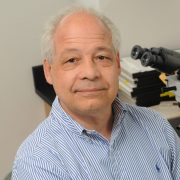Stem Cells and Tendon Regeneration
In the fall of 2014, 4-VA awarded Dr. Jennifer Barrett at VT $30,000 to collaborate with Dr. Lance Liotta at UVA and Dr. Virginia Espina at GMU on a project called Leveraging inter-university collaborations to decipher proteomic mechanotransduction pathways in stem cell-seeded tendon scaffolds in a dynamic bioreactor.
The goal of this work is to better understand how stem cells (SCs) can be influenced to make tendon and ligament using both mechanical tension and protein additives (growth factors), with a longer-term goal of engineering functional replacements for ruptured tendon and ligament. Researchers aimed to establish a collaborative interdisciplinary undergraduate/graduate research project between Virginia Tech’s Marion duPont Scott Equine Medical Center and George Mason University.
The study set out to determine similarities and differences between SCs isolated from different tissue sources, and the influence of tendon-associated growth factors on graft development. While their ultimate goal of developing an ideal tissue engineered tendon graft will not be achievable in the time frame of these experiments, they plan to elucidate key factors critical for developing such a graft. The alternative clinical approach of injecting tendon stem cells into areas of injury can be developed in a shorter time frame. The plan is to use this information as preliminary data for an NIH R01 parent grant application and for fellowship support for graduate students through both the NSF and the U.S. Department of Defense.
Dr. Jennifer Barrett
Associated Professor, Large Animal Clinical Sciences
Dr. Lance Liotta
Co-Director & Co-Founder of the Center for Applied Proteomics and Molecular Medicine (CAPMM)
Dr. Virginia Espina
Research Associate Professor and Director of the CAP accredited clinical proteomics laboratory in the CAPMM




